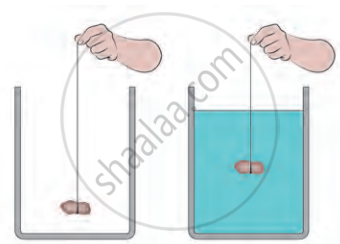1. Aim: To observe how buoyant force reduces the tension in a rubber band when a stone is submerged in water.
2. Requirements: A long rubber band, a clean washed stone or a 50 g weight, and a pot of water
3. Procedure
- Cut a long rubber band and tie a stone or a 50-gram weight to one end. Hold the other end of the rubber band and make a mark at the top.
- Measure the length of the rubber band from the stone to the mark while the stone hangs in the air.
- Submerge the stone in a pot of water and measure the length of the rubber band again. Note that it is shorter.

Buoyant Force
4. Conclusion: The rubber band stretches less when the stone is submerged in water. This happens because a buoyant force acts upward on the stone, reducing the downward force of the stone’s weight. The reduced tension in the rubber band indicates that buoyant force opposes the stone’s weight, demonstrating Archimedes' Principle.

